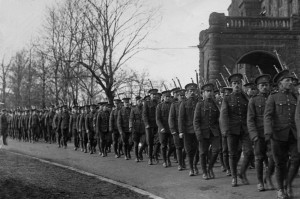This is a continuation of my comments from this post.
Because I read Holding the Line on my e-reader, I was able to easily copy quotes that I found interesting. I reproduce them here for my own reference and, hopefully, your enjoyment.
Here’s a bit about the equipment assigned to each infantryman: Hanging from the belt is the entrenching tool and handle; it is shaped like a tiny grub hoe. One would be apt to be amused at the idea of digging a hole with a toy like that, but under shell fire you could dig a hole quicker with that little tool than with a pick and shovel. Next is the haversack worn on the left side and the water bottle on the right. In the pouches attached to the belt and braces a hundred and twenty rounds of ball ammunition are carried. In addition to all this a man takes his blanket and oil sheet rolled on the top of his valise.
This lengthy anecdote, also relating to equipment, took place immediately after Baldwin’s arrival in France. At five o’clock in the morning we were issued goatskin coats, mittens and gloves, and inspected by the O. C. The order came to march, and in heavy marching order, we trudged to the depot. This marching order consists of rifle and bayonet attached to braces, which in turn are attached by self-locking buckles to the belt, the knapsack or valise which usually contains a shaving kit, towel, soap, change of underwear, socks, one pair of boots, mess tin, and any other little convenience you may wish to carry. Later on we learned by bitter experience to dispense with everything except absolute necessities. The aforesaid goatskin coats were a gift from the then Czar of Russia and were supposed to have come from China. When we had donned our gift coats there was a perceptible murmur of comment running from end to end of the ranks, caused by the odor from the presents of the Czar not unlike the presence of a skunk. Examination disclosed that the bloody (literally) coats were dotted in many places with the actual flesh of the deceased animals still sticking to them. In spite of stern orders from the O. C’s. of the various companies to maintain silence during inspection, it was plainly discernible that the smell had penetrated even the seasoned nostrils of the officers themselves, from the Colonel down….I am certain that the Germans would have been badly frightened that we had a poison gas of our own if we had had a chance to tackle them with our coats on when the stink was fresh and full in its pristine glory, as it was when we first got them.
Baldwin refers to his experience of the Zonnebeke Road at Ypres, at least I think he does, since he calls it the “Z– Road.” (Edmund Blunden’s poem The Zonnebeke Road.) At last we emerged on the road, and, to my dying day, I shall never forget the sights that met our eyes. Everywhere were shell craters, both on the road and on each side of us. In every shrine, where the Belgians placed their crucifixes, men in agony from the gas had crawled and died there; dead bodies, dead horses, wrecked ambulance cars, gun limbers, ammunition limbers, and in one place were six of the very finest horses I have ever seen, with their drivers, dead. Villages, where the people had been living when we went up, were now utterly desolate; everything a smoldering mass of ruins, such had been the fury of that shell fire. And it was still going on, shells screaming over us or bursting close by.

For those who’ve read War Horse or seen the recent movie, here’s a mention of one way the British army used horses: I must tell of the men who were supplying our guns with ammunition. Six horses on a limber, with three drivers, and two carriers on the limbers, would trot steadily to the bomb-proof shelter where the ammunition was kept, load up, and still at the steady trot return to the guns. All the time heavy shrapnel was bursting overhead, and the awful crack of this shell is enough to break the strongest nerve.
Though the memoir was intended as propaganda, I still found some of the imagery riveting.
